Among the most exhilarating experiences that will give you an adrenaline high while also creating a sense of calm is freediving. There are millions of freediving practitioners worldwide that this underwater activity has transformed. Although there isn’t much equipment involved in freediving (that’s what the ‘free’ in freediving means), swim fins are used by many.
After rigorous testing, we compiled a list of the five most popular freediving fins available and tried them out to give you an in-depth review to help you buy the most suitable freediving fins for you. We’ve tried them with a variety of tests and tried to remain objective throughout.
| FREEDIVING FINS FOR BEGINNERS | BRAND | EXPERT RATING | PRICE |
|---|---|---|---|
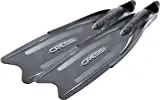 | Cressi Store |  | |
 | SEAC Store |  | |
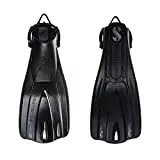 | Scubapro Store |  | |
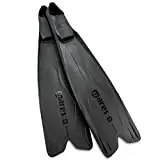 | Mares |  | |
 | Cressi Store |  | |
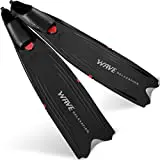 | WAVE Store |  |
Why Do Freedivers Use Fins?
Freedivers can reach depths of water that normal swimmers can’t, all on one breath. So, it is important that they make their time underwater as efficiently as possible. Fins help freedivers swim great distances while utilizing less power. They can also help increase the depth that a diver is capable of reaching.
Fins are especially helpful for beginners because they may not have as much control over their breath and need more help to increase the efficiency of their dives. However, beginners must first learn the proper finning techniques.
Fins create a vortex behind them and channel water in a propelling motion. The propulsion forces the diver’s body forward, increasing the distance traveled per kick. In this way, divers can use less energy (by kicking less powerfully) to achieve the same result.
Because freedivers are using a single breath for the entirety of their dive, any energy conservation translates to more time spent underwater. Fins are not the only equipment used to achieve this, as freedivers also use neck weights (or weight belts) to increase the time spent underwater by sinking faster and spending less energy on achieving neutral buoyancy.
What Exactly Is Finning?
Finning is a technique that divers (of every kind) use to maneuver the water better and increase their forward motion using swim fins. This is very similar to the way that a fish propels itself in water by moving its fins. It takes a lot of skills and training to develop the correct finning technique.
It is important that scuba divers, freedivers, and other underwater swimmers realize that equipment such as swimfins can only improve on the existing propulsion of their technique. In simpler terms, we can say that fins are useless if the diver does not know the proper finning technique.
Additionally, different swim fins are designed with different purposes in mind, and thus each type requires a different technique. For example, paddle fins are shorter and require more flutter kicks. Freediving fins require a slower, more mermaid-like motion.
Freediving Fins Vs. Scuba Fins
Not all swim fins are created equally. Each has a purpose and is designed accordingly. The first thing anyone who takes a look at freediving fins will notice is that they are very long. Freediving fins come in many sizes, with the standard blade (everything without the foot pocket) being anywhere between 31 and 39 inches.
Compare that to scuba fins, which are generally much shorter with blade length at a maximum of 30 inches. Scuba divers do not need as much power as freedivers, but their fins need to withstand the extreme water pressure at the depths they are able to reach.
So, scuba fins are somewhere in between snorkeling fins and freediving fins. In this article, we will mainly be focusing on freediving fins.
Beginners Guide On How To Choose Freediving Fins
Many factors come into play when choosing freediving fins, especially for beginners. These are some of the things you need to keep in mind before selecting freediving fins.
Material
Fins are usually made of either plastic, fiberglass, or carbon fiber. Some are also made using a blend of materials or elastomers. Each material has its pros and cons, so choose depending on your needs.
Plastic is more stiff and durable. However, it does not compare to the flexibility and the snap created when using carbon fiber or fiberglass fins. They are a good option if you’re still new to freediving because they won’t be damaged if you scrape them by the rocks while swimming (which is more likely if you’re still an amateur).
Carbon fiber, fiberglass, and other more flexible materials are more difficult to handle. They are generally only recommended for professional divers and swimmers that will get the most out of them without damaging them.
Keep in mind that many types of plastic materials have varying degrees of stiffness and durability. Some fins use multiple materials to create a balance between comfort, efficiency, and power.
Comfort
Of course, you should feel comfortable wearing, diving, and finning in the swim fins you choose for yourself. Look for models that feel soft and do not constrict your feet. The blade angle is another aspect that you may need to consider.
Different companies try to claim they have the perfect angle for finning, but the physics behind it is much more complicated than they make it seem. Every foot is differently shaped, and every swimmer may have a slightly different finning technique, so this can be a very subjective matter.
PRO TIP: many divers wear neoprene socks to ease the rubbing from their dive fins. Be careful, though, because if the socks are thicker than 3mm, you may be losing power to the socks and thus inefficiently using your energy. Socks can also help get a better fit if your feet are between two standard sizes.
Flexibility (stiffness)
Many divers make the mistake of thinking that blade flexibility is dependent on the depth they are diving to. Flexible fins provide more snap and thus more propulsion. The perfect snap is usually correlated to the diver’s musculature or the power of their kicks, so you may need to try out a few before you decide on a preference.
Generally speaking, if you’re on the smaller side (less than 130 pounds), you should consider super soft (extremely flexible fins). Otherwise, soft fins are perfect for beginners and anyone else. Blades with medium flexibility are more useful for spearfishers (freedivers that swim in strong currents and catch large fish using a spear) because the stiffer blades will be able to withstand the water current.
Design Features
There are so many fin designs that it can get confusing for beginners. Forget about the advanced design features and focus on the simple parts you understand. Things like an open foot or full foot design can make a difference for some types of freediving. Replaceable blades are a nice feature as well but tend to be on the expensive side.
Other Features To Consider
You may also want to keep in mind the price of available fins. Also, not all fins need to be black, and many come in diverse colors for you to coordinate your outfit and freedive in style. Don’t let extra like travel bags and dive masks and other offers lure you into buying the wrong fins.
Buy the fins you are convinced you will enjoy using, but keep in mind that fins will not improve your swimming technique or freediving skills. They will only enhance your efficiency, possibly prolonging the time you spend underwater.
Product Review: Freediving Fins For Beginners
After testing many fins and going on what feels like weeks of dives, these are the best options we could find. We hope that our reviews can help you in selecting the most suitable freediving fins. As previously mentioned, we have tried to remain objective and base our opinions on facts from the testing methods used.
We went for three dives at different locations for each product we tested to keep the testing process fairly standard.
#1. Gara Professional LD – By Cressi
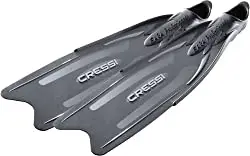
Photo credit: Amazon
The sleek Italian design and enhanced flexibility of the thermoplastic rubber make this model by Cressi a great choice for beginners. The first thing we tested for was how securely fastened the fins were on our feet. No matter how much we kicked, they wouldn’t come off on land and underwater.
We found the foot pocket incredibly soft, and its position under the blade made finning with these extremely easy and effortless. I was able to swim to greater lengths using these, and they were easier on my ankles. We believe this is due to the angle of the foot pocket under the blade. The manufacturer advertises that these fins may be used for scuba diving and snorkeling, but we are doubtful that they can be used for anything other than freediving.
Summary of features:
- Soft, comfortable feel
- Durable material
- Lightweight
- Sleek design
- Great energy dispersion for maximum power from effortless kicks
#2. Scubapro GO Sport
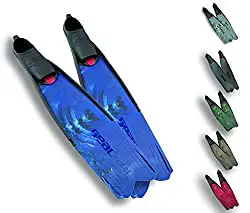
Photo credit: Amazon
Shorter than most freediving fins, the Scubapro GO Sport is just as great for freediving as it is for scuba diving. They are lightweight and compact so that you can take them with you on your travels easily.
Also, we enjoyed the array of color choices they provide. The material seems to be durable monprene, and it’s quite sturdy. I didn’t particularly like the blade angle at 25 degrees, but that’s just me. You may prefer it that way because our testing team had variable opinions about the pre-angled blade.
Several clever design features in these fins, such as the tough grip rubber insignia at the soles (which prevents slipping when walking on a boat) and the bungee strap at the ankles that adjust to your size perfectly.
You can wear these with whatever size socks or even boots if you need to, so cold water freediving is made easier with these fins. Keep in mind that they tend to be on the bigger side, and you might need to get a size smaller than your shoe size.
They are designed to be worn with neoprene boots or socks, so comfort is more dependent on the type of your boots or socks.
Summary of features:
- Monprene sturdy material
- Open heel design with marine grade bungee strap
- Lightweight and compact – perfect for travel
- Can be worn with boots
#3. Cressi Reaction Pro
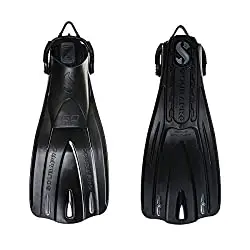
Photo credit: Amazon
Yet another great pair of fins from Italian manufacturer Cressi. We absolutely loved these soft fins, as they were very light on the feet. The pocket covers the entire foot and has rubber reinforcements to keep it secure in place. These fins aren’t extremely long but perform just as well as longer fins.
Our team tested them out for freediving and scuba diving alike and found they function well in both cases. None of the team members felt sore feet after two hours of scuba diving, which only proves how comfortable these fins are. They are slightly expensive but arguably worth the price.
Beginners will find that a polypropylene blade is flexible enough to help channel water behind them and create much more propulsion than you’d expect. The blade starts from your heels, which is supposedly a design feature (along with the directional rails) that enhances the efficiency of your kicks.
The only major drawback would be that you cannot wear any socks under them (except maybe 1mm neoprene), which means cold water freediving isn’t feasible with these. These fins are more suitable for people with thin, long feet. If you have particularly wide feet, you may feel a little uncomfortable in them. They come with a travel bag for easy transportation.
Summary of features:
- Durable plastic
- Innovative blade design
- Compact
- Rubber reinforcements make for a secure foot pocket
- Travel bag makes it easy to transport
#4. Mares Instinct Pro
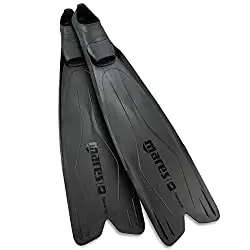
Photo credit: Amazon
These fins are more suitable for spearfishing than any other type of diving but can be an excellent choice for beginners because they are suitable for freediving and snorkeling as well. The blades are excellently elastic and flexible, giving the diver enhanced efficiency even in shallow waters.
At 32 inches, they require side ribs to keep the blades supported. Surprisingly, the technopolymer seems to withstand very strong currents easily, so we expect this will be a durable pair of fins. They aren’t compact enough to carry around easily, but that is expected with fins this size.
We found the foot pocket to be comfortable enough to use barefoot, so you may want to get them in your exact size. The blades are the most innovative part of these fins, with multiple design features that are meticulously designed to take every last bit of power from your kicks and turn it into forward propulsion.
They are designed to give the perfect shape for channeling water and micro-ribbed to optimize efficiency.
Summary of features:
- Perfect blade design for water channeling
- 32-inch blades
- Technopolymer material is flexible but strong
- Comfortable enough for barefoot
- Can comfortably be used for freediving, snorkeling, and scuba diving.
#5. WAVE Long Blade Diving Fins
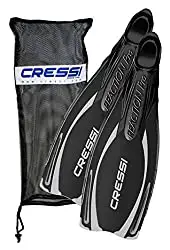
Photo credit: Amazon
These did especially well on our dive tests and were the longest we tried (over 35 inches). The blades are not just flexible but also super-elastic. Still, we were satisfied with the quality of the material used, which is a type of tough thermoelastic plastic.
The blades are interchangeable according to the manufacturer, but we couldn’t find any, so we will not comment on that feature. We did, however, find many accessories that help keep the fins in their best shape. WAVE also advertises a 30% increase in propulsion efficiency, which is fairly close to the results from our testing (we average at around 27%).
As for comfort, our entire team loved finning with these because the foot cover was just perfectly snug. The foot pocket also has soft rubber in some parts to keep them feeling soft. We didn’t mind wearing them barefoot or with 1mm neoprene socks.
The entire fin is very light to wear and even lighter to swim in, with a noticeable increase in efficiency. Walking in these fins (both on the surface and underwater) was great as well because the non-slip rubber soles provide the perfect grip.
Summary of features:
- Extra-long blade (35.4 inches)
- Increases propulsion efficiency by up to 30%
- Soft rubber foot pockets
- Non-slip rubber soles
- Interchangeable blades
- Durable material
#6. Seac Sub Motus
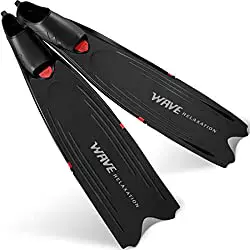
Photo credit: Amazon
Last but not least, we tried out the Seac Sub Motus fins. We kept them for last because we got a lot of requests for them, and we wanted to stay objective in our review. They come with replaceable blades, and you can opt for their odd-looking camo design that we loved (but have no idea why, if that makes sense). They have seven different color options.
Seac really took the time to perfect each detail in designing these fins, and the resulting quality is proof. The blades aren’t too stiff and snap responsively to give the best forward-propelling motion with your kicks when you’re finning. Light and thin, they are a snug fit with no size discrepancies we could find.
They easily fit 3mm neoprene socks for cold water freediving. The foot pocket is manufactured from two different materials to give more comfort in the interior and a hard exterior for better control and enhanced performance.
Changing the blades means you can get a longer or shorter blade as needed and adjust stiffness according to your preference as well. Seac Sub offers different blades to cater to freedivers of all different experience levels.
Carbon fiber blades are for experienced divers, as they are fragile and easily broken but give high performance when used correctly. They also offer a fiberglass blade which is somehow better than plastic but less fragile than carbon fiber. Nonetheless, they recommend the plastic blade (technopolymer) for beginners, and we second that opinion.
The blade angle is 22 degrees, which was comfortable for most of our team. It brings a balance between increasing efficiency, maneuverability, and power. They have a fishtail shape and aren’t overly long (22 inches). Changing the blade is simple enough; all you need is to loosen two screws from the bottom, attach the second blade and fasten the screws again.
Summary of features:
- Replaceable blades
- Easy blade changing
- Multiple blade material
- Two material comfortable foot pocket
- Flexible blades with excellent snap
- Seven different colors offered
Final Advice
Buying fins online can be much cheaper than going to a dive shop and certainly more convenient. It is easy to compare millions of offers online, and many stores these days offer quick shipping.
The only drawback is that you will need to rely on others’ recommendations to figure out how the fins will feel on your feet. The best solution for online purchases of this kind is to make sure the store has a return policy. If you don’t like the material or the fit, you can always return the fins and buy a better option or a different size.
Always try on new fins at home before planning a freedive. They may not be the most important piece of equipment on a freediver, but you don’t want to find out they’re too big (or too small) at the last minute.
If you prefer to buy your equipment at a physical store, don’t hesitate to ask for help from the store owners or even other shoppers. The diving community as a whole loves to help each other, and you never know what you might learn if you don’t ask!
Also, insist on trying on the swim fins in-store and closely inspect the material and design. Do not simply go for the most expensive fin because it may be more suitable for an experienced freediver. Take your time shopping, because your fins may last for a long time.
Now that you’ve explored everything that you need to know about freediving fins, you can make an informed purchase and select the more appropriate and suitable fins for yourself.
Even if you do not follow our recommendations about the five best freediving fins, you will be able to use this advice to make a better purchase. Overall, we hope we have benefited you somehow with this article.
If you want to learn about spring fin straps check our article here.
